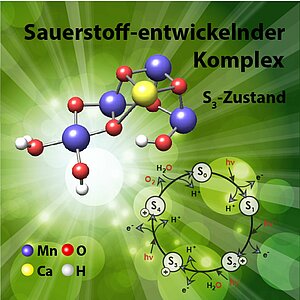An international research team including the Max Planck Institute for Chemical Energy Conversion (MPI CEC) in Germany and The Australian National University (ANU) has published new results on how nature performs biological water splitting, a process that underpins all life on the planet. The results can be valuable for the production of CO2 free ‘solar fuels’.
The study, led by Dr. Nick Cox, a former group leader of MPI CEC in the Department of Prof. Wolfgang Lubitz, now at ANU Research School of Chemistry, focused on the photosynthetic enzyme which performs biological water splitting, Photosystem II. Buried within this large protein complex is a cofactor consisting of four manganese and one calcium metal ions. It is this cofactor that performs the water splitting reaction, binding the two waters in close proximity to allow them to join together to form a single oxygen molecule. The study reveals how the cofactor is activated, a process that involves the highly regulated uptake of water from its surroundings.
The study was a collaboration between researchers at the MPI CEC, also with Prof. Serena DeBeer, and the MPI für Kohlenforschung (MPI KOFO) in Mülheim/Ruhr, Germany, the Ruhr University Bochum in Germany, Uppsala University in Sweden and the Australian National University, Canberra, and was recently published in Proceeding of the National Academy of Sciences of the United States of America.
Detailed results can be found in the press release or in the paper in PNAS.
Chrysina, M., Heyno, E., Kutin, Y., Reus, M., Nilsson, H., Nowaczyk, M. M., DeBeer, S., Neese, F., Messinger, J., Lubitz, W., Cox, N. (2019). Five-coordinate MnIV intermediate in the activation of nature’s water splitting cofactor. Proceedings of the National Academy of Sciences Aug 2019, 201817526; DOI: 10.1073/pnas.1817526116

